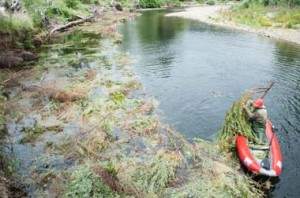This post from Bill Monroe explains how a very simple Christmas cleanup shift can do a world of good to fish. Does anyone know if there’s a similar program in other Northwest areas? -KH
Many years ago in a land far away (Las Vegas, where else?) I covered several Oregon outdoor companies attending the annual Shooting Hunting and Outdoor Trade (SHOT) Show, one of the nation’s top two dozen largest trade gatherings.
Among the more interesting exhibits was that of a boot manufacturer (no, not from Oregon) that had a display of four boots on a wheel, which turned round and round much like a mill wheel. Except the water was in a tray beneath the wheel, to show the footwear’s water resistance as each boot was partially submerged.
Also in the tray were a few goldfish (the booth people weren’t sure why they were there either) that scattered every time the boot left the water, then scurried into the shallow space beneath the sole as each boot re-submerged.

Byren Thompson of Seaside uses a kayak to place Christmas trees and branches in a quiet backwater of the Necanicum River to help protect baby salmon. Michael Ellis photo.
They were, of course, using the boots for cover, instinctively protecting themselves from overhead dangers – like outdoor reporters with cameras.
But when I turned in the photo, a non-outdoor copy editor assumed the fish were instead running from the boot to keep from “being stomped on” and turned the photo 180 degrees from reality with a far different description in the cutline.
We smiled and shared our “goldfish moment” for years until his retirement.
Cut to present, a Christmas present to be exact, and one you can still give – to a fish.
For the next three Saturdays, Jan. 4, 11 and 18, the Tualatin Chapter of Trout Unlimited will be collecting your used (and non-tinseled, please) Christmas tree to shelter baby salmon and steelhead in a coastal stream. It’s called “Cohoho” and a $10 bill should accompany your donation to help defray transportation costs from eitherNorthwest Fly Fishing Outfitters, 10910 NE Halsey St. in Portland, or Royal Treatment Fly Fishing, 21570 Willamette Drive in West Linn. Hours are 9 a.m. to 4 p.m.
(That, incidentally, is about the same cost as the new Columbia Basin salmon, steelhead and sturgeon angling endorsement. And it will do just as much good for salmon and steelhead; on the coast, perhaps even more.)
Volunteers will take the trees to the Necanicum River on the coast and rope some of them into quiet winter backwaters, beaver ponds and wetlands, places where newly hatched salmon and steelhead spend their first few critical months of life. Most will be placed in late spring as the water drops and the needs for shade and structure become even more critical.
At some point next fall, before the first freshet, the ropes will be untied and the trees (branches also are “rescued” from landscapers’ chippers) will simply be washed whimsically downstream to land where they may. It’s not unusual to spot them out in the Necanicum estuary in all months of the year. Even there, they provide critical structure for salmon and steelhead.
Trees do double and triple duty. First, they provide shade and shelter, helping keep the water cool and protect the fish from predators such as mergansers. Later, as the branches decay, they become hosts for all sorts of waterborne organisms providing the base of an important food chain.
It’s the ultimate in woody debris, nearly duplicating nature’s pre-pioneer litany of deadfall, detritus and biological structure.
Yes, Christmas trees are indeed subject to a lot of herbicides and pesticides, but chemicals are used in the spring and have short half-lives. After all, if they’re safe enough to be in the house around your kids, they must be all right for fish.
The program is in just its third year, so no tangible analysis (measurable adult returns, etc.) are available for another year or two. However, young fish respond from within minutes to a few hours and seek out the new shelter; adult coastal cutthroat trout by the hundreds gather with lamprey eels around the algal remains of old trees. Enthusiastic supporters want the effort expanded to other coastal streams.
And even, most importantly, to Metropolitan Portland and the Willamette Valley.
A Christmas tree, it turns out, is also a gift that can keep on giving.


